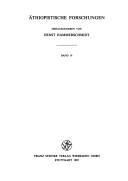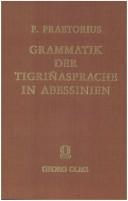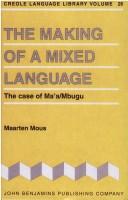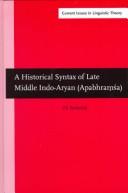| Listing 1 - 10 of 13 | << page >> |
Sort by
|

ISBN: 3515043144 9783515043144 Year: 1985 Volume: 19 Publisher: Wiesbaden: Steiner,
Abstract | Keywords | Export | Availability | Bookmark
 Loading...
Loading...Choose an application
- Reference Manager
- EndNote
- RefWorks (Direct export to RefWorks)
Tigrinya language --- Tigrai language --- Tigray language --- Tigrenna language --- Tigrensis language --- Tigrigna language --- Tigriña language --- Tña language --- Ethiopian languages --- Tigrinya language - Readers

ISBN: 3487051915 Year: 1974 Publisher: Hildesheim Olms
Abstract | Keywords | Export | Availability | Bookmark
 Loading...
Loading...Choose an application
- Reference Manager
- EndNote
- RefWorks (Direct export to RefWorks)
Tigrinya language --- Grammar. --- Tigrai language --- Tigray language --- Tigrenna language --- Tigrensis language --- Tigrigna language --- Tigriña language --- Tña language --- Ethiopian languages --- Grammar

ISBN: 9027252483 1588114899 9786613327703 1283327708 9027275246 9789027275240 9789027252487 9781283327701 6613327700 Year: 2003 Publisher: Amsterdam : Benjamins,
Abstract | Keywords | Export | Availability | Bookmark
 Loading...
Loading...Choose an application
- Reference Manager
- EndNote
- RefWorks (Direct export to RefWorks)
Mbugu language --- Grammar. --- Creolan languages --- Dialectology --- Kibwyo language --- Ma'a language (Tanzania) --- Mbougou language --- Vama'a language --- Wa maathi language --- Languages, Mixed --- Grammar
Book
ISBN: 9788188769469 Year: 2010 Publisher: Mumbai : Hindi Granth Karyalay,
Abstract | Keywords | Export | Availability | Bookmark
 Loading...
Loading...Choose an application
- Reference Manager
- EndNote
- RefWorks (Direct export to RefWorks)
Apabhraṃśa language --- Rāma (Hindu deity) in literature. --- Grammar.
Book
ISBN: 1283398257 9786613398253 3110211777 9783110211771 9781283398251 9783110188424 3110188422 661339825X Year: 2008 Publisher: Berlin ; New York : Mouton de Gruyter,
Abstract | Keywords | Export | Availability | Bookmark
 Loading...
Loading...Choose an application
- Reference Manager
- EndNote
- RefWorks (Direct export to RefWorks)
This book is a detailed high-quality descriptive grammar of the endangered Cavineña language (less than 1200 speakers), spoken in the Amazonian rainforest of Lowland Bolivia, an area where the indigenous languages are virtually unknown. Cavineña belongs to the Tacanan family, comprising five languages, none of which has been the subject of an adequate descriptive grammar. The grammar is based mostly on the extensive fieldwork conducted by the author in traditional Cavineña communities. Cast in the functional-typological framework, and based on natural discourse data, the grammar presents a detailed and copiously exemplified account of most aspects of the language, building up from basic levels (phonetic and phonological) to higher levels (morphological and syntactic), and from brief descriptions of each level to a more comprehensive description of the same level in specific chapters. The language contains a number of unusual features that will be of interest to typologist linguists, such as an unusual pitch accent system, a morpho-phonological rule that deletes case markers, an intricate predicate structure, a system of verbal suffixes coding associated motion, a specific causative of involvement marker, a peculiar prefix e- that attaches to nouns coding body parts and a complex system of second position clitic pronouns. The grammar will also be of interest to historical-comparative linguists, as for the first time one has sufficiently detailed grammatical information to make possible a reliable comparison with other languages with which Tacanan languages might be related, in particular the Panoan family, and to serve as input into hypotheses regarding the population history of this part of South America.
Cavineño language --- Cavina language --- Cavineña language --- Cavinenyo language --- Cavinya language --- Kavina language --- Tacanan languages --- Grammar. --- Bolivia. --- Latin America (language). --- Cavineno language

ISBN: 1283312298 9786613312297 902727567X 9789027275677 1556198817 9027236704 9789027236708 9781556198816 Year: 1998 Publisher: Amsterdam : Benjamins,
Abstract | Keywords | Export | Availability | Bookmark
 Loading...
Loading...Choose an application
- Reference Manager
- EndNote
- RefWorks (Direct export to RefWorks)
This monograph aims to close the gap in our knowledge of the nature and pace of grammatical change during the formative period of today's Indo-Aryan languages. During the 6th-12th c. the gradual erosion of the synthetic morphology of Old Indo-Aryan resulted ultimately in the remodelling of its syntax in the direction of the New Indo-Aryan analytic type. This study concentrates on the emergence and development of the ergative construction in terms of the passive-to-ergative reanalysis and the co-existence of the ergative construction with the old and new analytic passive constructions.
Apabhraṃśa language --- Indo-Aryan languages, Middle --- Middle Indo-Aryan languages --- Apabhramsha language --- Syntax. --- Grammar, Historical. --- Grammar --- Historical linguistics --- Indic languages
Book
ISBN: 9783110188424 Year: 2008 Publisher: Berlin Mouton de Gruyter
Abstract | Keywords | Export | Availability | Bookmark
 Loading...
Loading...Choose an application
- Reference Manager
- EndNote
- RefWorks (Direct export to RefWorks)
Grammar --- South American Indian languages --- Cavineño language --- Cavina language --- Cavineña language --- Cavinenyo language --- Cavinya language --- Kavina language --- Tacanan languages

ISBN: 3540053778 0387053778 3540364994 9783540053774 Year: 1971 Volume: 188 Publisher: Berlin: Springer,
Abstract | Keywords | Export | Availability | Bookmark
 Loading...
Loading...Choose an application
- Reference Manager
- EndNote
- RefWorks (Direct export to RefWorks)
Computer. Automation --- 519.767 --- Semantics of a language: mathematical aspects --- 519.767 Semantics of a language: mathematical aspects --- Computer algorithms --- Formal languages --- Programming languages (Electronic computers) --- Algorithmes --- Langages formels --- Langages de programmation --- Congresses --- Semantics --- Congrès --- Sémantique --- Congrès --- Sémantique --- Algorithms
Book
ISBN: 3944773306 3944773314 Year: 2021 Publisher: Frankfurt am Main Max Planck Institute for Legal History and Legal Theory
Abstract | Keywords | Export | Availability | Bookmark
 Loading...
Loading...Choose an application
- Reference Manager
- EndNote
- RefWorks (Direct export to RefWorks)
This book argues that the narrowing focus of the global history of ideas on narratives in historical research, philosophy and political theory neglects the fact that the central concepts of the history of political ideas are articulated in the language of law. Key figures of the history of ideas, like Kant, Hegel and Weber, engaged deeply with the philosophy and sociology of law. This monograph reveals the significance of the legal semantics of the history of ideas.
Law --- Language --- Philosophy --- History --- Acts, Legislative --- Enactments, Legislative --- Laws (Statutes) --- Legislative acts --- Legislative enactments --- Jurisprudence --- Legislation --- History of ideas; history of languages; The language of law as a language of politics; Universal Natural Law; International law as a language of justification; Justice through the rule of law; The juridical construction of sovereignty --- Philosophy. --- History.
Dissertation
Year: 2018 Publisher: Liège Université de Liège (ULiège)
Abstract | Keywords | Export | Availability | Bookmark
 Loading...
Loading...Choose an application
- Reference Manager
- EndNote
- RefWorks (Direct export to RefWorks)
Depuis le début de l’interprétation de conférence dans de grandes institutions, l’interprétation biactive a suscité de vives controverses chez les interprètes. Pourtant, la demande en interprétation biactive ne cesse de croître. Dans le but de mieux comprendre la réalité de l’interprétation biactive sur les marchés privé et institutionnel, ce travail présente d’abord, dans un volet théorique, les différentes écoles de pensée qui avancent les avantages et les inconvénients de l’interprétation biactive. Ensuite, des statistiques de la Commission européenne, de l’Organisation pour le Traité de l’Atlantique Nord et de l’Association internationale d’interprètes de conférence font état du nombre d’interprètes fonctionnaires et indépendants biactifs anglais < > français à Bruxelles. Enfin, une étude qualitative et exploratoire menée sous forme d’entretiens semi-structurés permet d’analyser et de comparer le profil de douze interprètes biactifs anglais < > français travaillant sur le marché privé et/ou institutionnel à Bruxelles. Les entretiens montrent que l’interprétation biactive existe et qu’elle est nécessaire puisque sur le marché privé bruxellois, la plupart des interprètes sont biactifs et certaines organisations internationales n’engagent que des interprètes biactifs. L’étude met en évidence certaines tendances liées à l’apprentissage d’une langue B, mais aussi liées à la préférence de chaque interprète à travailler vers la langue A ou vers la langue B. En outre, les entretiens dévoilent les difficultés qui ressortent le plus lors d’une interprétation vers la langue B et les stratégies pour les surmonter. Ils mettent aussi en lumière l’avis des participants sur l’importance de la compréhension et de la restitution. Étant donné que l’échantillon a été étudié d’un point de vue qualitatif et ne concerne qu’une fraction de la population totale, les résultats de cette étude ne peuvent nullement être généralisés. Néanmoins, les conclusions de l’analyse pourraient inciter à une nouvelle réflexion et jeter les bases pour d’autres recherches.
Interprétation de conférence --- Interprétation biactive --- Langue A --- Langue B --- Écoles de pensée --- Marché privé et institutionnel --- Conference interpreting --- Biactive interpreting --- A language --- B language --- Schools of thought --- Private and institutional market --- Arts & sciences humaines > Langues & linguistique
| Listing 1 - 10 of 13 | << page >> |
Sort by
|

 Search
Search Feedback
Feedback About UniCat
About UniCat  Help
Help News
News